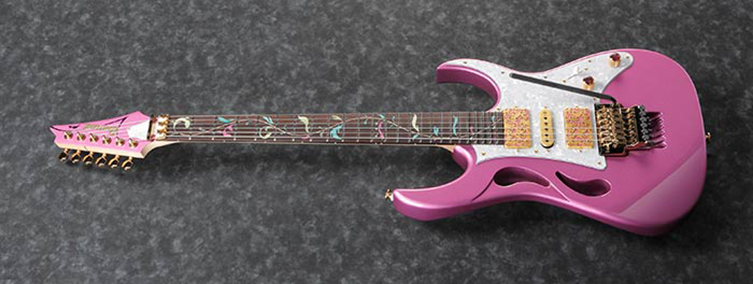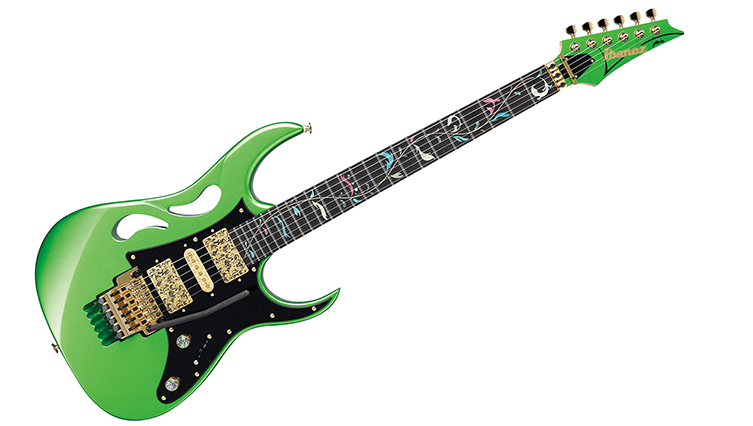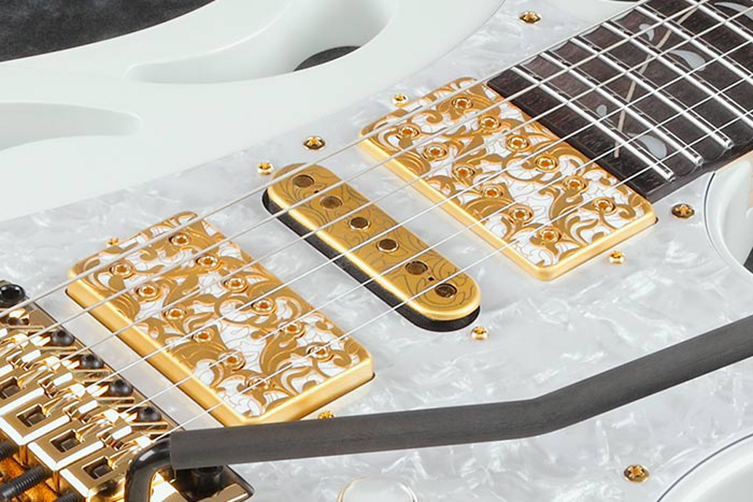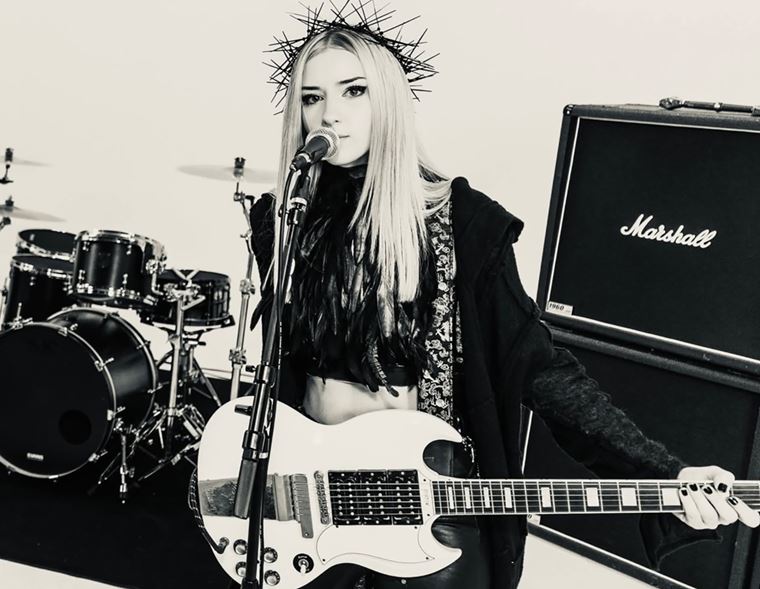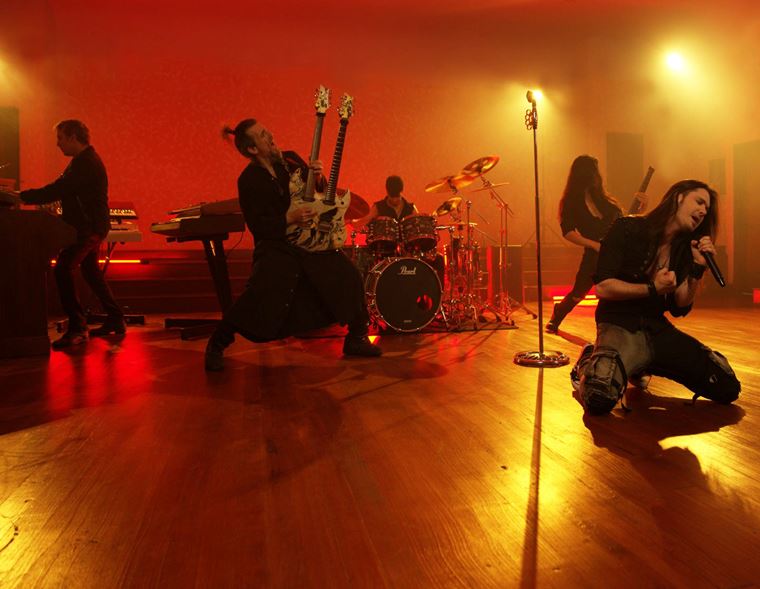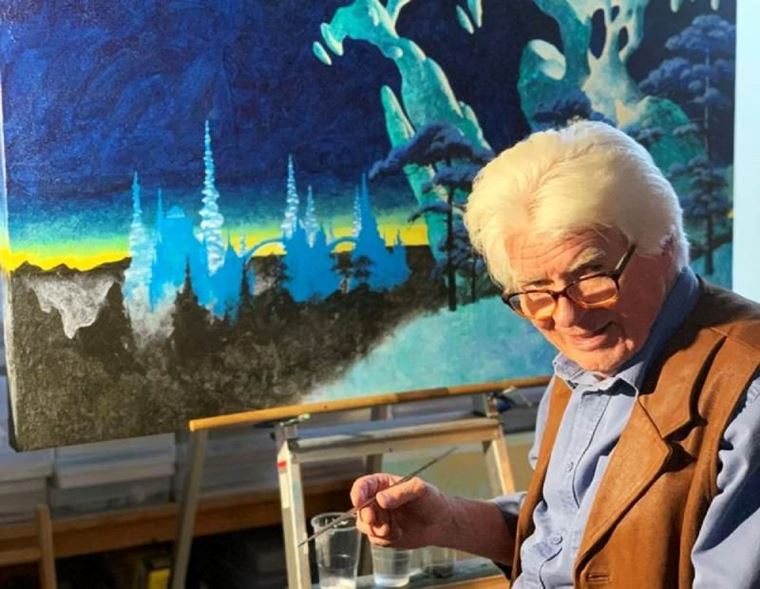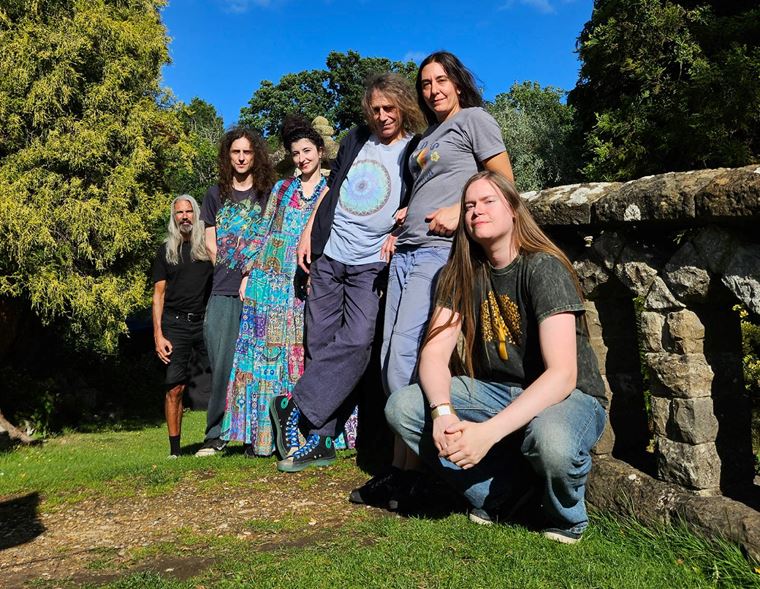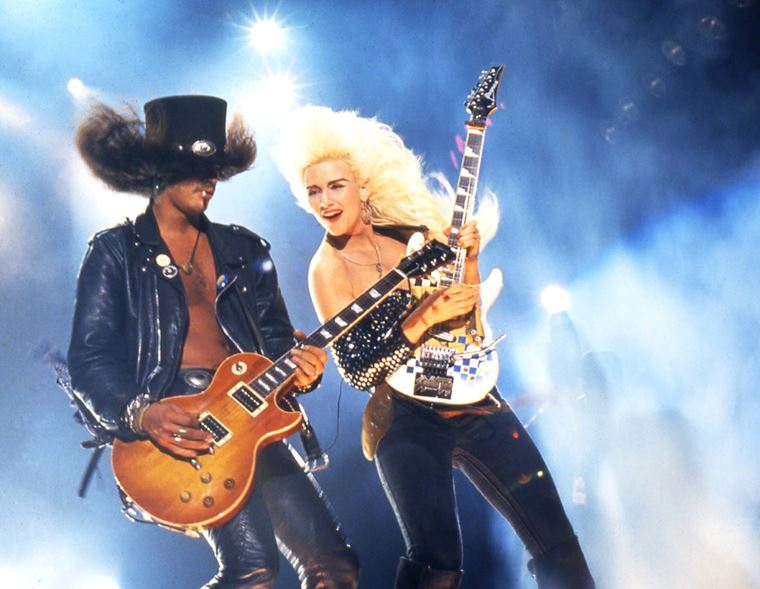The guitarguitar Interview: Steve Vai (Part 1)
Published on 20 March 2020
When did you first hear Steve Vai?
Was it back when he played for Frank Zappa, and was tasked with transcribing near-impossible-to-play music at age 18?
Maybe it was when he played lead guitar for David Lee Roth, which involved stepping into some of the most intimidating shoes in Rock history?
Perhaps his tenure with Hard Rock legends Whitesnake?
Maybe you saw him playing Jack Butler, the Devil’s guitarist, in the movie Crossroads? (talk about perfect casting?...)
My first experience of Steve Vai? I was a teenager and one of my school friends decided to put on Alien Love Secrets in Art class one day. He was a fellow guitarist and had taken a chance with his pocket money (that’s how young we were) to get the CD since Vai was on the cover of Total Guitar that month. This was the mid 90s, and the guitar parts we normally heard on the radio belonged to the likes of Blur and Kula Shaker.
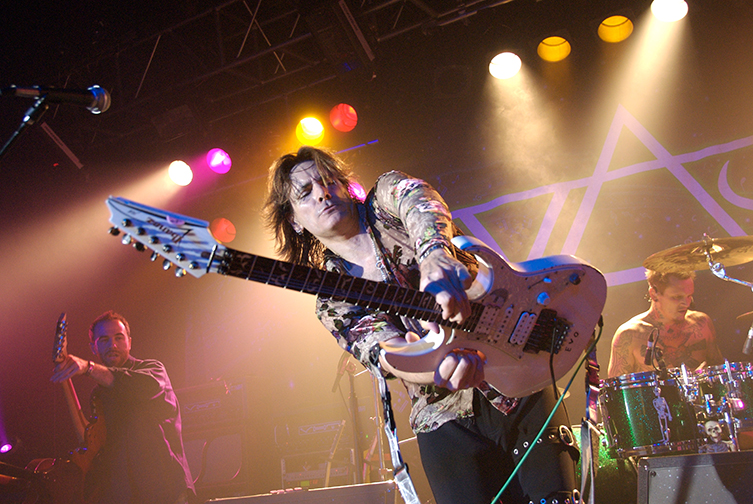
(photo: Michael Mesker )
With no disrespect to those bands, you can just imagine the effect Vai’s otherworldly playing had on us by comparison. Was it the speed? Probably not, since an appreciation for the speed came later: it was too intimidating for my grungey 13 year old self.
Was it the strange, wild noises? Probably. We’re getting closer, definitely. I couldn’t believe what this man could do with his whammy bar, and instantly regretted blowing years of savings on a Les Paul copy.
But that wasn’t entirely it, either.
There was just something about those songs and sounds that was beamed in straight from a different planet! It was a newness (to my ears, anyway), the opening of a door to an exotic place I’d never visited before. That was what was really happening, I think. I can never hear those songs again the same way I first heard them, but I can remember the seismic shocks that happened and continued to happen, and I get a kind of sense-memory of them each time I put that album back on. ‘Powerful’ doesn’t describe it.
I’m sure we’ve all had our Steve Vai moments throughout our years as players. Those days when we decide we’re going to learn For the Love of God in its entirely, as if doing so will open some magical door to another realm. Steve Vai inspires these ideas in us, with his uniquely beautiful, human, alien music. Whether you first heard him with Whitesnake or Zappa or whatever, I bet you know exactly what I’m talking about.
Talking to him would probably be amazing.
This year, Steve announced the Ibanez PIA guitar at the Winter NAMM show. The PIA is a beautiful, updated re-drawing of his iconic JEM, and is the first ‘new’ model (there have been a great many JEM variations over this years) in well over two decades. Vai’s army of fans went nuts, and pre-orders sold out before the show ended.
Straight after this, Synergy announced a brand-new Steve Vai amp module! This was exciting news too, given that Synergy have broken new ground with their valve modules that recreate fully licensed, ‘proper’ preamps from the likes of Diezel and Friedman. It’s a new dawn of amplification, and Steve Vai, with his brand-new signature module, is at the epicentre.
As you likely already know, at guitarguitar, we are authorised dealers for both Ibanez and Synergy. We are also massive Steve Vai fans! It seemed that the planets were coming somewhat into alignment here, with the new guitar and amplifier being released so closely together. I sensed a potential for positive action. How often do I get an excuse to bug Steve Vai’s people for an interview?
With what I do, it’s never a given that people will automatically just agree to talk to me: quite the reverse, in fact. However, I think it was Virgil who said something that I’m going to paraphrase here: ‘fortune favours the persistent types who stick their necks out often enough’. Wisdom.
To that end, word about my interview request got through the ranks, via Synergy, to Steve himself. I wasn’t expecting a ‘yes’ from him to tell you the truth, but I’m always the guy who will try! However, on this occasion, that planetary alignment was strongly in my favour, because a yes was indeed what I got! My inner teenage self screamed and ran around the room in delight as I pushed the ‘reply’ arrow to casually begin an email back and forth with one of the most famous and gifted guitarists in the world.

A few days later, the time came around and we had our conversation. This was one of those once-in-a-lifetime phone calls. In my initial proposal, I had asked for twenty minutes, understanding that I’d need more but would probably not get it. In the end, as I spoke to Steve at his home in Los Angeles, I must’ve caught him in a chatty mood because we ended up speaking for nearly an hour and a half! This is why we’ve made the decision to split the interview into two parts: they are each still a long read, but they’ll hopefully be more digestible in this format.
Anyone who has seen videos of Steve talking on YouTube will know how intelligent and eloquent he is. He is very comfortable to speak with authority on a number of subjects that relate to music and creativity. He frequently moves the subject away from the ‘hows’ to the ‘whys’, and shares deep insights into the spiritual and inner realms that fuel his inspiration and motivation. This is the kind of stuff I really wanted to get from him, and as you’ll see, he didn’t disappoint! I’m happy to report that Steve, in conversation, is exactly as I thought he’d be: charming, funny, easy-going and very charismatic. What I also found out is that he is very humble, very happy to share things and very supportive in his nature.
I hoped for a good conversation but instead I got a great one.
Part one of this Interview focuses on the PIA guitar to begin with, and the DiMarzio UtoPIA pickups. The conversation takes in a whole lot more, though: the idea of conforming, the notion of aesthetics in art, and the band Ghost! Please read and enjoy part one, which begins right here...

(photo: Larry DiMarzio)
Guitarguitar: Hi Steve! It’s Ray from guitarguitar. How are you?
Steve Vai: Hi, I’m doing great!
GG: Excellent, excellent! Thank you so much for agreeing to talk to me!
SV: Oh, my pleasure.
GG: So, Steve: we’ve got loads to talk about! I’ll try to fit as much in as I can, okay!
SV: You got it.
GG: So, I guess first of all, shall we talk about your new guitar, the Ibanez PIA?
SV: Sure!
GG: So, that guitar...I haven’t gotten my hands on one yet since it’s still a pre-order with us, but it looks stunning! It’s a total work of art!
SV: Oh, thank you, thank you so much! Yeah, we’re really happy with it. It was a long process, and it pretty much sold out at NAMM, you know? It’s kinda crazy!
GG: Yeah! There’s loads of what I would refer to as the ‘Steve Vai DNA’ in the PIA, from the legacy of the JEM and so on.
SV: Yeah.
GG: Do you see it as an extension of the JEM or an entirely separate animal?
SV: Well, it’s more an extension of the JEM. The guitar body, in and of itself, is the same, with the exception of rounded edges and certain angles kind of re-sketched a bit to work in harmony and symmetry with the petal grip. The other things that are different from the JEM, there’s not really that much with of course the exception of the grip. I mean, I don’t think it’s possible to design a guitar (laughs) with a better grip to grab it with than the Monkey Grip on the JEM!
GG: Absolutely!
SV: Yeah, you know, we kinda thought that, in the beginning, when I came up with that idea, it was kinda quirky? And very ‘Vai’? But I didn’t think anybody would really go for it, I didn’t really know!
GG: Yeah.
SV: So, the success was a big surprise. But I always felt it would be nice at some point to kinda reshape that. And the JEM is still being manufactured and still, you know, a great instrument and a great selling instrument, it’s just, aesthetically, and structurally a little different from the PIA. But the PIA is definitely like an evolution of the JEM.
GG: Oh, I like your wordplay there, Steve! That was good: the ‘Evolution’ of the JEM!
SV: Yeah! Haha!
GG: That was actually going to be my next question. The new DiMarzio UtoPIA pickups on the PIA: apart from them looking incredible, am I right in saying that they are also more powerful than your original Evolution pickups?
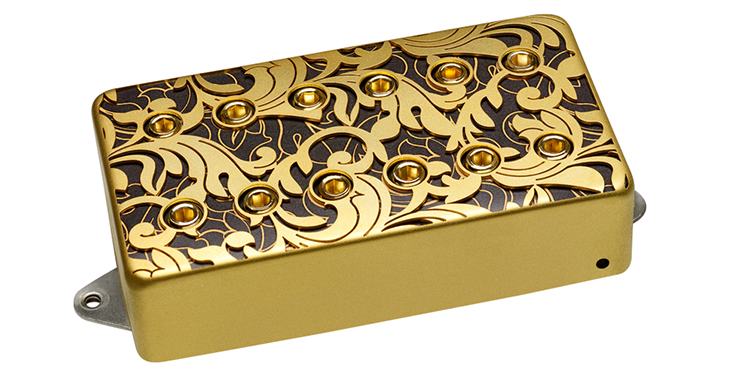
SV: Well, I started with the Evolutions, and I started to experiment with some of the frequency responses of the pickup. You know, we’re always on a never-ending quest to evolve what we’re doing, you know?
GG: Always.
SV: And the Evolutions are perfect the way that they are, but there’s always sort of a pull to evolve. So, in years of using the various DiMarzio pickups that I’ve designed – that have basically sprung from the Evolution – I would design continuous pickups based on the previous pickup. For this particular pickup, the UtoPIA, I went back to the Evolution and I listened to that. I played back on that for a while and started to imagine just a little bit of a different tonal landscape for them. So, I went to work with DiMarzio’s folks, and...checking pickups is a very forensic operation, you know, because every little thing that you change – whether it’s the guitar body, or the wiring, or the neck on the guitar – it does have some kind of an effect on the tone.
GG: Mmm.
SV: So, the way I like to check pickups is, I have one guitar made, and then I have like 5 pickguards made with pickups in them that are for me to test. Those pickups are based on my feedback to DiMarzio of the Evolution. That feedback sounded something like ‘I would like the top end to be just a little smoother and the bottom end to be a little tighter, and the mids scooped a little bit. There’s a load of numbers associated with this that I have some place. And as far as the output goes, the request there was just a tiny, tiny bit more output than the Evolutions, so I don’t really hear that much of a difference, you know?
GG: Okay.
SV: Yeah, but then I’d get the five pickguards, and I’d put one in the guitar, then I’d play and record it. Then I’d take that pickguard off, put another pickguard in, play basically the same thing – all different pickup selections, different levels, different amounts of gain – and I would do that for all five pickguards. I’d go through and listen back to the same guitar with the same electronics, with the exception of the pickups, and that would give me a pretty good barometer of the difference. You’d be surprised how wildly different these pickups can come in, you know?
GG: Oh yeah!
SV: So, then I picked three out of those...I guess it would be fifteen pickups altogether because five pickguards with prototype neck, middle and bridge position pickups...
GG: Sure.
SV: I had five of each to choose from and I’d choose one of each, make comments on those, send them back and get five more.
GG: Oh cool! You literally write on the pickguard and send it back?
SV: Yeah, yeah! So, I would go through probably fifteen different pickguards filled with prototype pickups to find the three out of, I guess, fifteen of each position.
GG: Yeah!
SV: So, for the UtoPIA, that’s basically what we did! That’s how we came up with those pickups.
GG: That’s awesome! Does that mean then that, yourself approaching the PIA guitar, and plugging into your rig, is gonna have a legitimately separate voice to, for example EVO (Steve’s number one JEM) when you pick that one up?
SV: Yeah, I notice a difference. The one main difference that I notice is EVO has a bump at like 1.5k.

GG: Ah!
SV: It’s got more of a midrange kind of a tone, and I just pulled some of that. The PIA’s more like a stereo tone, where it’s got a little more height and bottoms and highs.
GG: Yeah, that’s interesting about the mids: I’m just thinking of the Evolution pickup I have in the bridge position of my Gibson Les Paul, and how that pickup just suits it so well. I wonder whether it’s because of the inherent ‘midrangey-ness’ of the guitar?
SV: It could be! I mean, Gibsons in and of themselves carry sound really well. Les Paul?
GG: Yeah.
SV: Yeah, I mean that’s a big chunk of wood there! That will affect the sound of the pickup, too.
GG: Yeah, I think so too.
SV: But I’m glad it sounds good for ya! I like that there’s an Evolution in a Les Paul, haha!
GG: Oh yeah! I tried a few others but the Evolution always intrigued me. I thought: ‘I wonder...?’ and gave it a shot. Man, they should start doing that at the factory because it sounds wicked.
SV: Wow! Well, if you ever put a UtoPIA in that Les Paul, I’d be interested in hearing your thoughts on the difference!
GG: Sounds like a deal!
SV: I’ll have to call you and interview you!
GG: Yeah, you can interview me, hahaha! Hey, one thing I was thinking: obviously there’s the magnetic pull from the pickup to the strings. On the PIA, you have this amazing magnetic back panel, which is such a cool idea! But it just struck me there: might that affect the sound of the guitar in terms of it being a magnet pulling in the opposite direction?
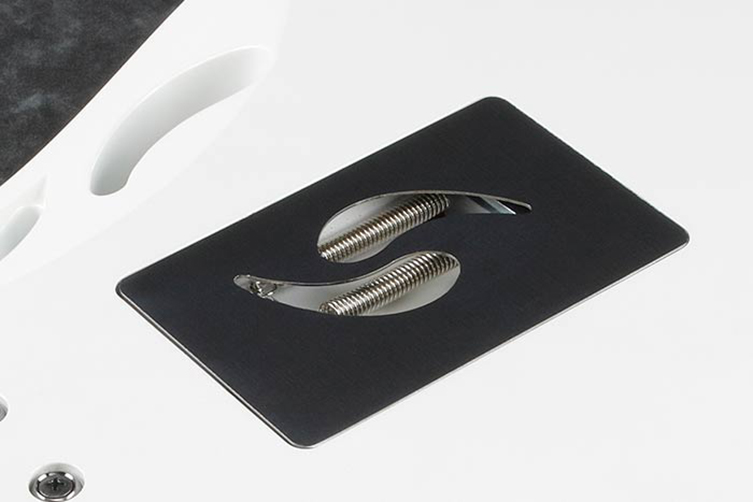
SV: Well, not only that, but the pickup covers on any guitar can have an effect on the way that the pickup resonates. This was a big concern when we were designing this. Originally, I wanted to use Velcro to hold the back plate, to avoid that.
GG: Okay.
SV: So, we tried a bunch of things and, just like I had mentioned, the forensic research that we did for the pickups? (laughs) As I was doing the tests, I did them with and without the pickup covers, with and without the magnetic backplates.
GG: Haha, wow! Right.
SV: Yeah. Now, what I discovered was yes, there was a little bit of a...maybe that’s why the UtoPIA sounds as though there’s not a lot more output than the Evolution...it could be: it’s hard to say if those magnets have an effect, but what I did notice is that they accentuate the top a little bit and the bottom. So that top end that I pulled out of the Evolution might be a tiny bit more accentuated in the UtoPIA with the PIA because of the magnets. But it’s like splitting hairs. So, for this particular design of the PIA, we decided to go with the pickup covers and the magnetic cover. Now, this guitar will evolve too, in the future: I don’t know if it’ll have pickup covers the way it does now, but the aesthetic will change. The bones of the guitar won’t change. There’re quite a few requests that I get from fans of the JEM and the PIA when I check online, you know?
GG: Yeah.
SV: I go on sometimes just to see what people are feeling about the guitar. And some people would love to have a signature PIA that is actually based around the changes that I put in my personal guitar, because there’s a couple of things that I do on my guitar that are not on the production guitar, such as: I kinda like lightly scalloped frets. I didn’t wanna put that in the production model only because it’s a very acquired taste, you know?
GG: Sure is!
SV: I don’t think there’s a huge audience for scalloped frets. So, I decided to pass on that. We may do that in the future, we may do a real kind of ‘Vai’ guitar with these various changes in it. The other thing that I usually do is, on probably three quarters of my guitars, the newer ones at least, is I put a Sustainer in it.
GG: Yeeeahhh.
SV: Yeah, that’s a big part of my performance. I use the Sustainer quite a bit, actually. The problem with putting one of those in a production model for me was, way back when I first discovered the Sustainer, it was made by this company called Fernandes.
GG: Yes.
SV: I love this device! It suited my playing, you know? And as soon as I got it, I wrote that song Whispering a Prayer...

(photo: Sergey Tynku)
GG: I was just listening to that an hour ago! It’s beautiful.
SV: Oh, thank you! Thank you. You can really hear the Sustainer use in that. But the problem was, Fernandes was a small company, and when they made these, they were kind of...although they were all performance worthy, I found inconsistencies. Like, some units were just better than others. So, I would have to go through 4 or 5 of them to pick one to put into a guitar.
GG: Ah, I see, I see.
SV: Yeah. Which required me to ostensibly purchase all of the ones that were available.
GG: Oh, that’s where they’ve all gone! That’s why we can’t get hold of any stock: Steve Vai’s bought them all! Hahaha!
SV: Yeah probably! That’s what Ibanez tells me! So, to put them in a production model just wouldn’t work because you can’t get enough! So then, through the years, I experimented with the Sustainiac, which really is a fantastic unit but there was always something about it that, um, didn’t work for me. One of those was the sound of the pickup itself: it didn’t have enough output. It sounded almost too single-coiley, ya know?
GG: Yeah.
SV: And also, when you go into the high harmonics setting, there’s like...when you don’t play, there’s this weird feedback that happens. But we discovered that this problem was a result of a particular way the unit needs to be installed so that was figured out. Recently I hooked up with the guys from Sustainiac, and they are very interested in working with me to design, or to just tweak their existing model a bit, so I can start using it on all my guitars, because the Sustainiac’s a very good system. They’re pretty bullet-proof, you know? So, I think if we could tweak it a bit, to my taste, then I could consider releasing it in a potential future model of the PIA that’s really based on my guitars.
GG: That’s exciting!
SV: Yeah! But I think the scalloped frets, the Sustainer and...what else? Oh yeah, I use a trem-setter. A trem-setter is a little spring-loaded device in the cavity in the back of the guitar where the springs are, so that the whammy bar isn’t entirely floating: it kind of rests on these springs when I’m in the neutral position. It makes it easier to tune, it makes it easier to use the bar, I mean it makes the note clearer because with a floating system, when you hit a note, the note vibrates because the trem just goes like B-r-r-r-r-r.
GG: Yeah, that’s true.
SV: It vibrates because it’s floating. The only disadvantage to using a trem-setter is you don’t get that really smooth vibrato when you just touch it a little bit because it hits the springs in the back a little bit. But I’ve worked around that and it works for me.
GG: Yeah, you can’t really have a Steve Vai guitar where the whammy bar isn’t working for you! It’s such an integral part of how you express yourself, isn’t it?
SV: Yeah it is, it’s like my concerts occasionally turn into Floyd Rose seminars or something (laughs)!
GG: Hey, there’s nothing wrong with that! I’ve got a Floyd Rose-related performance question for you later, if we have time! It’s funny you mention the quality control issue with those Sustainers: there was a recent guitar model that had problems that way too. It’s a shame, the Sustainer just opens up one’s playing.
SV: For a player like me, the Sustainer is a game-changer. As a matter of fact, I composed this piece of orchestra music some years ago, and it consisted of me holding one note for 18 minutes...
GG: Oh wow!
SV: While the orchestra weaved in and out of it!
GG: Oh! Did you release that?
SV: Well, I performed it about three times with various orchestras, and it was recorded, but I wasn’t happy with the recordings. They were live recordings and they weren’t great performances, and that’s the case with about 4 hours of my orchestra music. So, I decided that this Summer, starting with the end of May, I’m going into a studio in Holland to record a lot of that music with the North Netherlands Orkest. Then, in the first two weeks of June, I’ll be with the Aarhus Denmark Radio Orchestra to record some big symphonic pieces. And this is why I don’t have a new solo record.
GG: Hahaha!
SV: Because I’ve been working on these scores endlessly. It’s intensive work! (laughs) So, after the Summer, I should be able to start putting together my next solo record. And I should be out on tour in 2021.
GG: Oh cool, and would this next solo record be the third part of the Real Illusions trilogy?
SV: That’s the plan right now! (laughs) I hate talking about it, only because I usually change my mind, haha!
GG: Yeah, well, ya know!
SV: This record was supposed to come out years ago, and I find myself getting involved in all of these other really cool projects!
GG: Well, that’s not a bad problem to have, Steve!
SV: No! And I get to do Generation Axe, which is this fabulous project. I can say that we are seriously looking at February time next year for a European Generation Axe tour. But you never know. Things change and it’s always best to flow with changes. I always see change as leading to a new way of doing things, or new discoveries. The most difficult thing about Generation Axe is getting everybody’s schedules together.
GG: Of course!
SV: Everybody has solo careers and bands, you know, Nuno’s got Extreme, Zakk’s got Ozzy, and we have to weave in and out of Ozzy a lot: that’s the priority for Zakk, so...and Zakk has his own band. But we really love touring together, that’s the whole thing! It’s like, when we get together, it’s such a great touring experience, it’s like a bunch of guys that’ve paid their dues and are now just allowed to go have a lot of fun with each other, you know? It’s one of my favourite tours ever.
GG: Awesome! I’m looking forward to catching that: I loved the G3 stuff from before and this seems like the next step on in madness.

(photo: Michael Mesker)
SV: Yeah, it’s pretty mad!
GG: Cool! Here, Steve: I’m thinking about your Floral JEMs from back in the day, and your Tree of Life inlay that’s on your JEM7, and the PIA which has the Petal Grip and all of the floral motifs over it, and I’m wondering...now, this might be me being a pretend sort of synaesthesiac or whatever, but whenever I listen to your music, it always reminds me of being inside some sort of colourful, exotic garden, or far-off place. Would you say that there’s a connotation there that connects the way your guitars look to the way your music sounds?
SV: Absolutely! I think that’s a very good, valid point that you made: I see it too!
GG: Oh cool!
SV: I’ve been seeing these things for quite a while, you know. When I look back at my career, at my music, as is with any artist that’s pretty dedicated to their creativity, you start to see various art and elements and colour, things like that. And I definitely get what you’re saying there because even from Passion and Warfare, where the cover was festooned with flowers and very colourful, and all my records seem to have the artwork. The guitars themselves, they’re very kind of ah, extroverted!
GG: Yeah! But it’s appropriately so!
SV: Yeah, and the music itself follows suit, as one would expect!
GG: Yeah!
SV: They all come from the same place, you know what I mean? (laughs)
GG: Yeah, well maybe that’s what makes it such a powerful thing altogether? It’s a complete statement. And the fans of the music, if they are guitar players, then they want to play Steve Vai songs on the JEM because it’s the correct instrument for it, you know? It all follows.

(photo: Larry DiMarzio)
SV: Hahaha! Yeah, you could look at it like that! What’s interesting is that any artist that really has the flow, meaning they’re allowing their unique kind of identity to flow into all of those things, like the music or the artwork, the clothes they wear, the way they perform on stage...I mean, when you look at me, for instance – and I live in a very small field in the music business, the instrumental Rock guitar world, it’s a small part of the music business, and the music business itself is a small part of all the businesses in the world – but in this little world, I have an opportunity to be completely free. And I always felt that way! I always kind of felt that, when I went to write a piece of music, for myself or one of my records, there was always an intent.
GG: Yes.
SV: And that intent, you can see, basically, in the personality of my whole thing, which is: music, the way the guitars look, the clothes I might wear, the way I move, all these things. And any artist that goes there...that’s what the fans really respond to. The authenticity of their expression.
GG: Yes indeed.
SV: And a lot of, I mean, a lot of creative young players don’t go there. And the reason why people may not go to their true creative instincts, their unique creative instincts, is because of various kinds of fear or voices in their head that are telling them that their music isn’t good enough, or that it isn’t going to fit in, or it’s not the thing that’s gonna make them famous. That it’s not the thing that’s gonna be accepted. And then there’s fear of failing and all this stuff, so they conform. And this, I believe, for a truly creative person, is unnecessary. It’s unnecessary to conform to anything.
GG: You’re kind of out there flying the flag for everybody else to kind of put a little more of themselves out on the line.
SV: Well, um, maybe a little bit, maybe I can be a bit of an inspiration for that kind of thing, but there’s so many, you know? There’s so many...jeez, when I grew up, there were people like Jimmy Page, Brian May, Queen, Jimi Hendrix...all of these kinds of artists were completely connected to their unique expression, you know? And we’re so moved by those. That was my inspiration, especially working for Zappa.
GG: Yeah, of course!
SV: When I was with Frank, I just saw a guy who did whatever the fuck he wanted.
GG: Yeah! That’s as good as it gets, isn’t it?
SV: Yeah, it was quite a learning experience, because I was so young and impressionable. There’s nothing like seeing someone like Frank Zappa making stuff up on the spot...testing it right in front of your eyes and you’re a part of it and you realise: ‘well, I have the freedom to do anything I want too, with my own music’! It’s fantastic!

(photo: Michael Mesker)
GG: Yeah, it’s almost like permission from a mentor to go and explore. In terms of this generation of players, you really only get people like Empire of the Sun going out dressed in incredible outfits like they’re from some 80s fantasy movie. Everybody else is maybe a little bit...they’re all needing that memo that says you can go out and be more expressive, I think.
SV: Yeah.
GG: So, I think it’s really good that you attach importance to expressing that.
SV: Yeah, well, I’m lucky because I continue to be inspired by people who are expressing something unique. It’s funny: a lot of times, through the years, my introduction to various brilliant artists came through my wife.
GG: Oh, cool!
SV: She loves music and she homes in on certain artists, usually before me, and then she’ll turn me on to them. This was how I first heard Prince! And Madonna, those were the kinds of things she listened to. And she recently turned me onto this band called Ghost.
GG: Oh, I saw Ghost the other month. They’re fantastic.
SV: And I just love this guy, Tobias Forge, and his whole thing! It’s beautiful, because he’s just fearless, first of all. And every little part of his expression, you can tell it comes from him. The music, it’s got this thing in it that’s so interesting but is just one part of the whole presentation of it all. His vision is comprehensive. It incorporates many dimensions including the outfits, engaging concepts, mystique, lyrics, stage show etc. But the most powerful element for me in that music is the melody. It has inspired melody in it and that’s always a winner. So this thing is kind of happening with musicians that are really compelled, and that’s always inspiring. How was that show?
GG: Oh, that show was spectacular! I saw them about five years ago and it was very good, but I expected them to sound so much heavier, because of the way they looked at that point!
SV: Yeah, me too!
GG: You know what I mean? But that show there was probably about as good as an arena rock experience can be. It was so meticulous and so exciting, and, you know, they’ve flat out got tunes! It’s that way that you can just love the music even if you don’t care about the costumes.
SV: Yeah, it’s anthemic, it’s as arena-esque Rock as you can get, but (laughs) it’s got something else in it!
GG: Yeah!
SV: Same thing for me when I saw the outfits and didn’t hear the music. I remember seeing a picture of them in like a Japanese magazine or something and thinking: ‘Oh, this is one of those Death Metal bands’.
GG: Exactly!
SV: (Makes a gruff growling sound like a Death Metal vocalist) Hahaha, I got that wrong!
GG: Yeah, right? They sound like Blue Oyster Cult or something! It’s mental! What you were saying earlier reminded me of a quote by Tom Waits: ‘the way you do anything is the way you do everything’.
SV: Yeah, I love that.
GG: It kinda sums it up.
SV: Tom Waits is my favourite living artist.
GG: Really?
SV: Yeah, yeah. I don’t go anywhere without his entire catalogue.
GG: That comes as a surprise to me! I don’t know why I should, but I don’t really hear much of his influence in what you do, but I suppose it must be in there somewhere, right?
SV: Well, it’s in there somewhere: it’s gotta be! Of course, the Beatles are gonna be in there somewhere! (laughs) The thing about Tom is, you’re absolutely right: my music has nothing to do, almost, with his music. But, Tom is a completely artistic person. You know, when you listen to his music, he captures atmosphere in a way that’s unlike anybody else. You get to live in that atmosphere, it’s so authentic. Unbelievable!
GG: It’s like, the way he walks is the way he wears his hat.
SV: Yeah!
GG: Everything: it’s the whole picture.
SV: The whole thing, isn’t that funny?
GG: Which is what we get from you as well, Steve, so take a second and accept that for me, haha!
SV: Oh, thank you. I always feel, especially when I listen to somebody like Tom, that I can go deeper. Much, much, much deeper. And I think these next, uh, remaining years that I have, I think you’re gonna see that.
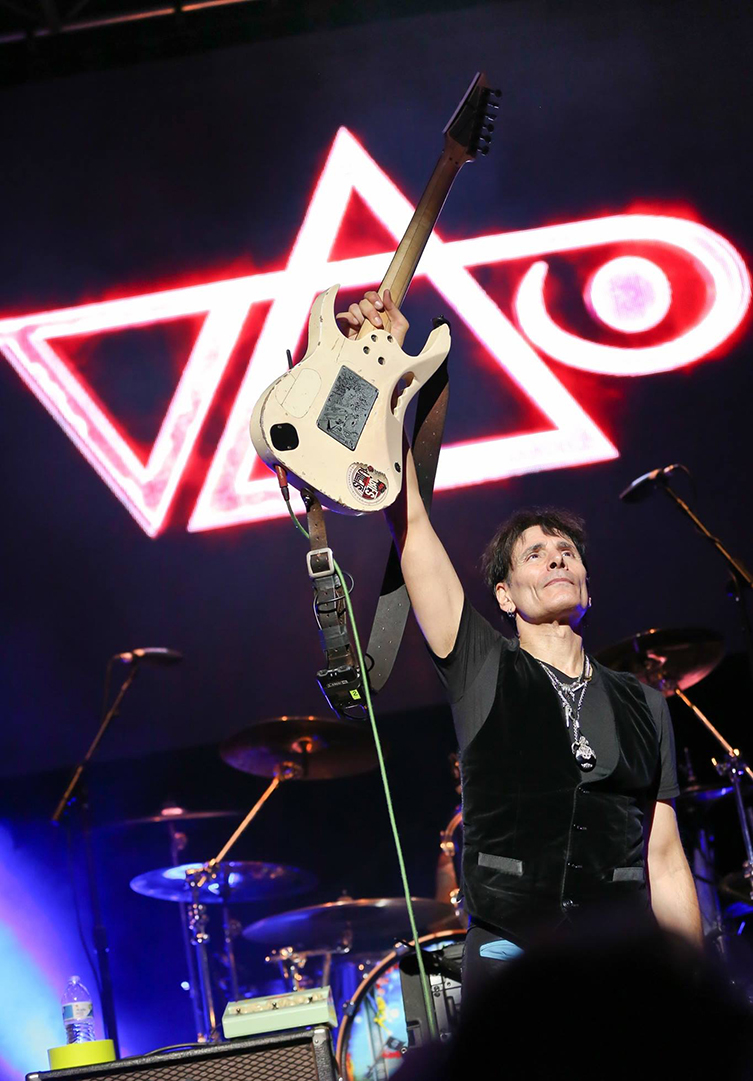
GG: I can’t wait! I can’t wait. Because you’ve already taken us pretty far. (Steve laughs) So, one thing that we haven’t spoken about yet, which we should, is your new Synergy module. I know that’s a total left-turn from what we were talking about there, but I’m really interested in hearing how you’ve gone from the Carvins, the Bogners and so on, to this new technology! So, can you tell me a little about the forthcoming Vai module?
SV: Yes, absolutely. I’d like to cap off a little bit on the PIA: I forgot to mention that the inlays are different also, on the neck. And this was something we spent a lot of time on. I mean, I tweaked the positioning of almost all the elements of the neck inlay, just a little bit. I would receive a photoshop illustration of the guitar and I could change little things. The other thing I would mention is the position of the petals. Where they are on the guitar: that took me...like, months.
GG: Wow.
SV: Just moving them a little bit! You know, a little bit this way, a little bit that way. Nothing felt right. I thought I had it at one point, and they made me a prototype. I looked at it and went: ‘Ah, it’s not quite there!’ Haha!
GG: That’s dedication!
SV: Haha, so I went back and tweaked it a little more. Finally, when those petals locked into place for me, it was like discovering a treasure.
GG: Amazing!
SV: You know like when you’re working on something and all of a sudden you nail it and get that ‘aha’ moment?
GG: Oooh yeah!
SV: Yeah, well that happened! When they brought me the first prototype, I couldn’t believe it when I looked at this guitar! When I got the four colours and I put them in the studio, I don’t know what it is, but when I look at this guitar, it has such an attraction to me, it’s like: ‘Ohh!’ I’ve always loved guitars, any guitar.
GG: Sure.
SV: Just from looking at them, you know? There’s just something about the way a guitar looks that just lights me up! And this guitar, when I see it – and not meaning to sound pretentious or anything – I mean, I am so lit up! I can hardly take my eyes of it! Haha!
GG: That’s what it’s all about, Steve!
SV: Yeah! The other thing I would mention is the design of the pickup covers was done by Artistic Illustrator Mike Mesker, who has basically been overseeing most of my art for some decades now. Every etching in the pickup covers relates to the whole design if you look at them carefully. Totally brilliant work.
GG: It certainly is. And you have four colours of PIA: which one is your immediate favourite?
SV: That’s a tough one. I’m pulled towards the green!

(photo: Larry DiMarzio)
GG: Yeeeeah! Me too!
SV: Yeah! I don’t know, they’re all just so beautiful, I can’t stand it. We’ll change it up for the future though. The guitar, when it came out, it had so many feminine qualities to it, in a sense, you know? It’s not really ‘edgy’. And, um, I guess that was something that suited me, you know?
GG: Right.
SV: I liked the feminine energy, so to speak. But the bones of the guitar, I think, have the potential to be pretty edgy, once we change the aesthetic in the future. So, yeah! I just wanted to mention that, the feminine energy. The feminine energy has always been attractive to me.
Here is where the tale ends for now. Please click the link below for the concluding part of this epic odyssey with the one and only Steve Vai! Thanks for coming along with us this far, we hope you enjoy part two!
Click Here for Steve Vai Interview: Part Two
Ray McClelland

